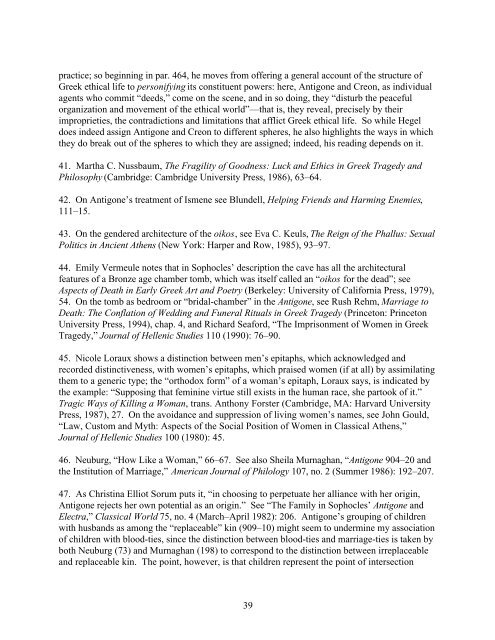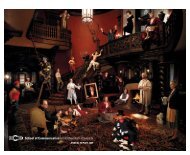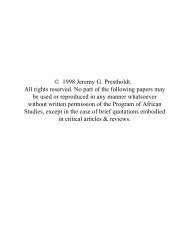TRAGIC RECOGNITION: ACTION AND IDENTITY IN ANTIGONE ...
TRAGIC RECOGNITION: ACTION AND IDENTITY IN ANTIGONE ...
TRAGIC RECOGNITION: ACTION AND IDENTITY IN ANTIGONE ...
Create successful ePaper yourself
Turn your PDF publications into a flip-book with our unique Google optimized e-Paper software.
practice; so beginning in par. 464, he moves from offering a general account of the structure of<br />
Greek ethical life to personifying its constituent powers: here, Antigone and Creon, as individual<br />
agents who commit “deeds,” come on the scene, and in so doing, they “disturb the peaceful<br />
organization and movement of the ethical world”—that is, they reveal, precisely by their<br />
improprieties, the contradictions and limitations that afflict Greek ethical life. So while Hegel<br />
does indeed assign Antigone and Creon to different spheres, he also highlights the ways in which<br />
they do break out of the spheres to which they are assigned; indeed, his reading depends on it.<br />
41. Martha C. Nussbaum, The Fragility of Goodness: Luck and Ethics in Greek Tragedy and<br />
Philosophy (Cambridge: Cambridge University Press, 1986), 63–64.<br />
42. On Antigone’s treatment of Ismene see Blundell, Helping Friends and Harming Enemies,<br />
111–15.<br />
43. On the gendered architecture of the oikos, see Eva C. Keuls, The Reign of the Phallus: Sexual<br />
Politics in Ancient Athens (New York: Harper and Row, 1985), 93–97.<br />
44. Emily Vermeule notes that in Sophocles’ description the cave has all the architectural<br />
features of a Bronze age chamber tomb, which was itself called an “oikos for the dead”; see<br />
Aspects of Death in Early Greek Art and Poetry (Berkeley: University of California Press, 1979),<br />
54. On the tomb as bedroom or “bridal-chamber” in the Antigone, see Rush Rehm, Marriage to<br />
Death: The Conflation of Wedding and Funeral Rituals in Greek Tragedy (Princeton: Princeton<br />
University Press, 1994), chap. 4, and Richard Seaford, “The Imprisonment of Women in Greek<br />
Tragedy,” Journal of Hellenic Studies 110 (1990): 76–90.<br />
45. Nicole Loraux shows a distinction between men’s epitaphs, which acknowledged and<br />
recorded distinctiveness, with women’s epitaphs, which praised women (if at all) by assimilating<br />
them to a generic type; the “orthodox form” of a woman’s epitaph, Loraux says, is indicated by<br />
the example: “Supposing that feminine virtue still exists in the human race, she partook of it.”<br />
Tragic Ways of Killing a Woman, trans. Anthony Forster (Cambridge, MA: Harvard University<br />
Press, 1987), 27. On the avoidance and suppression of living women’s names, see John Gould,<br />
“Law, Custom and Myth: Aspects of the Social Position of Women in Classical Athens,”<br />
Journal of Hellenic Studies 100 (1980): 45.<br />
46. Neuburg, “How Like a Woman,” 66–67. See also Sheila Murnaghan, “Antigone 904–20 and<br />
the Institution of Marriage,” American Journal of Philology 107, no. 2 (Summer 1986): 192–207.<br />
47. As Christina Elliot Sorum puts it, “in choosing to perpetuate her alliance with her origin,<br />
Antigone rejects her own potential as an origin.” See “The Family in Sophocles’ Antigone and<br />
Electra,” Classical World 75, no. 4 (March–April 1982): 206. Antigone’s grouping of children<br />
with husbands as among the “replaceable” kin (909–10) might seem to undermine my association<br />
of children with blood-ties, since the distinction between blood-ties and marriage-ties is taken by<br />
both Neuburg (73) and Murnaghan (198) to correspond to the distinction between irreplaceable<br />
and replaceable kin. The point, however, is that children represent the point of intersection<br />
39














